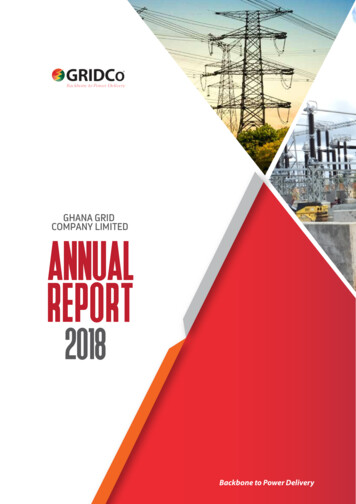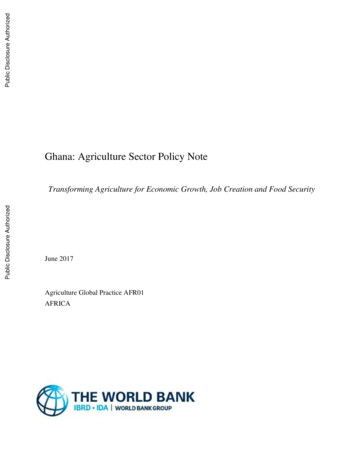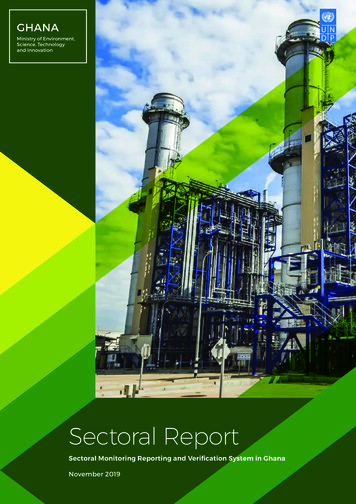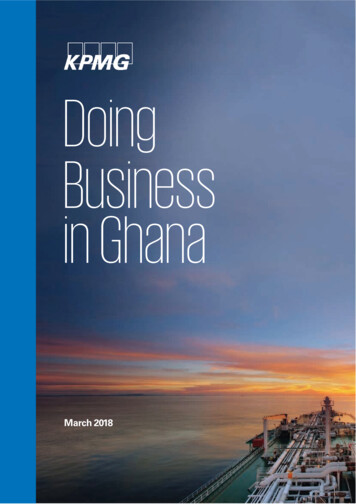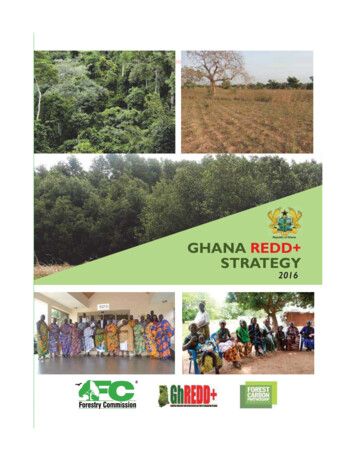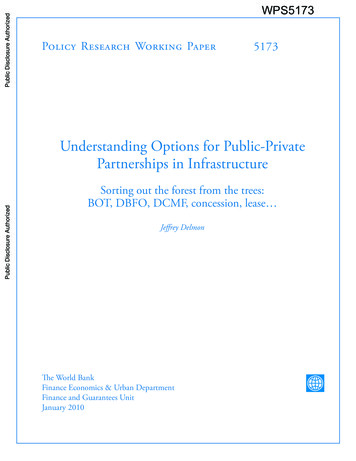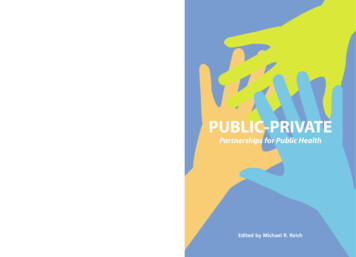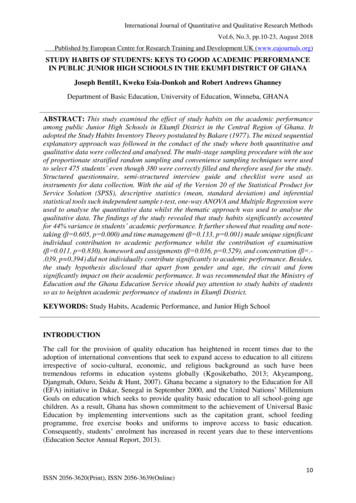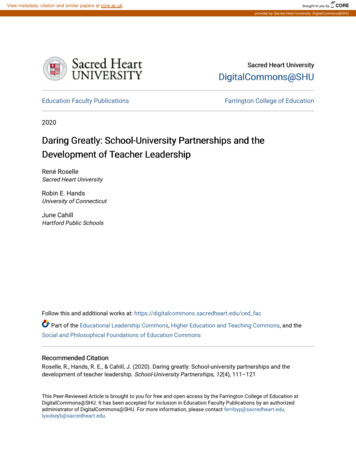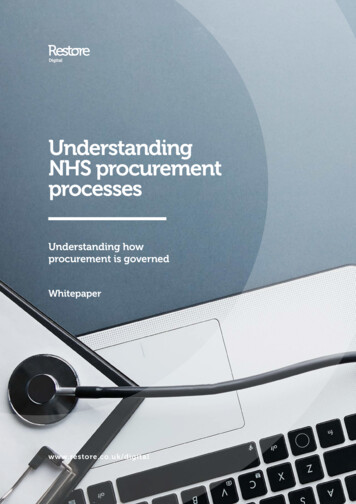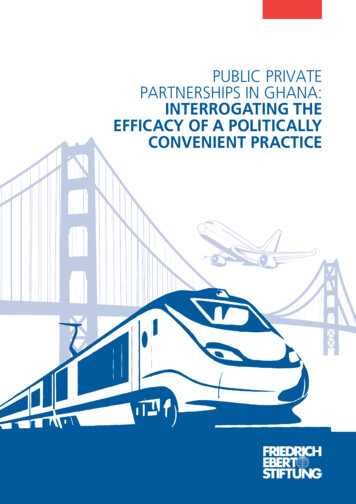
Transcription
PUBLIC PRIVATEPARTNERSHIPS IN GHANA:INTERROGATING THEEFFICACY OF A POLITICALLYCONVENIENT PRACTICE
ISBN: 9988-572-98-0Copyright 2018Published by: Friedrich Ebert Stiftung GhanaLayout and Printing by: Brand SynergyThe views expressed in this publication are those ofthe authors and not necessarily the Friedrich-Ebert-Stiftung.A commercial resale of published brochures, books andgeneral printed material by the Friedrich-Ebert-Stiftung isprohibited unless the Friedrich-Ebert-Stiftung gives itsexplicit and written approval beforehand.
PUBLIC PRIVATE PARTNERSHIPS IN GHANA:INTERROGATING THE EFFICACY OF APOLITICALLY CONVENIENT PRACTICESeidu Alidu (PhD)Dr. Seidu Alidu is currently a Senior Lecturer at the University of Ghana, Department of PoliticalScience. He is also an adjunct lecturer at the Centre for Social Policy Studies (CSPS) and the LegonCentre for International Affairs and Diplomacy (LECIAD) at the University of Ghana; a DonahueInstitute Scholar on United States political thought at the University of Massachusetts in the UnitedStates.He has worked closely with and for numerous policy think tanks including the Partnership for AfricanSocial and Governance Research based in Nairobi Kenya; Centre for International DevelopmentIssues Nijmegen based in Netherlands; the Institute for Democratic Governance; the FriedrichEbert Stiftung; The United Nations Development Programme, the Institute for DevelopmentStudies at the University of Sussex, the Ghana Armed Forces Command and Staff College, andthe German-African Governance Partnership Organization. He is a visiting lecturer at the Schoolof Public Policy and Administration at Mzumbe University in Tanzania and the School of PublicPolicy and Governance at Maseno University in Kenya. He has published widely, and presentedconference papers on different specialization areas including conflict resolution, democratizationand governance, transitional justice, civil society and social policy, as well as human rights.
ContentsTable of Contents iList of Acronyms and Abbreviations iiList of Tables and Figures iiiAcknowledgements iii1.0Introduction 12.0Theoretical Framing 32.1The Stewardship Theory 42.2Principal Agent Theory 53.0Types of PPP 64.0A Note on Methodology 85.0Historical and Legislative Evolution of PPP in Ghana 96.0Discussion of Findings 106.1Benefits of PPP to Local Assemblies106.2Competitiveness in PPP Projects 116.3Value-for-Money in PPP Contracting 126.4Transparency and Accountability 137.0Challenges in PPP Projects 157.1Land Ownership and Land Administration in Ghana157.2“Ancestral Space” and “Occupational Gifting”157.3Procedural Challenges in the Absence of PPP Law167.4Inadequate PPP Knowledge and Poor Negotiation Skills167.5Politicization and Continuity of PPP Projects178.0Summary, Conclusion and Recommendations 199.0Bibliography 2110.0Appendices 2310.1 Regional distribution of selected PPP projects in Ghana 2310.2 Interview Guide Public Private Partnerships In Ghana:Interrogating the Efficacy of a Politically Convenient Practice24i
List of Acronyms andAbbreviationsAbbreviation Meaning in FulliiADBAsian Development BankBOTBuild, Operate and TransferCCMACape Coast Metropolitan AssemblyCEOChief Executive OfficerDBODesign, Build and OperateDACFDistrict Assembly Common FundEIBEuropean Investment BankECEuropean CommissionFGDFocus Group DiscussionIGFsInternal Generated FundsKIIKey Informant InterviewsKMAKumasi Metropolitan AssemblyMCEMetropolitan Chief ExecutiveNPMNew Public ManagementOECDOrganization for Economic Co-operation andDevelopmentPPPPublic Private PartnershipSPStandard and PoorSTMASecondi-Takoradi Metropolitan AssemblyTaMATamale Metropolitan AssemblyTUCTrade Union CongressUCCUniversity of Cape CoastVFMValue for MoneyWBWorld Bank
List of Tables and FiguresFigure 1:PPP Stakeholders’ RelationshipFigure 2:PPP TypologiesTable 1:Collated Views of PPP BenefitsAcknowledgementsWe acknowledge the immense support provided by our research assistants in Tamale, Kumasi,Takoradi and Cape Coast; the staff and officers of the Tamale Metropolitan Assembly, the SekondiTakoradi Metropolitan Assembly and the Cape Coast Metropolitan Assembly. We also wish toacknowledge all the CEOs and staff of private companies that granted us interviews and themarket women, Assembly members and the general public that supported this research in variousways. Without your valuable support, it would have been practically impossible to conclude thiswork. We are indeed grateful.iii
1.0 IntroductionThe social contract that binds governments and the citizenry has both demand and supply sides.The supply side requires governments to provide for the basic needs of the citizenry includinginfrastructure and services; or at least create an environment for the realization of these needs orboth. The provision of these services and infrastructure by governments has a two-fold effect. First,it spurs development and second, it forms the bridgehead for the renewal of the contract that existsbetween a government and the people. The traditional form of public procurement used in mostindustrial countries has so far relied on some kind of unbundling (Martimort and Pouyet, 2006).First, the government designs the characteristics and quality attributes of the project. Second,the government chooses a private builder to build assets on its behalf but retains ownership ofthose assets. Finally, the government chooses an operator, who may be either public or private, tomanage those assets and provide the service. More recently, several initiatives around the worldand various legal reforms have proposed an alternative form of procurement called Public-PrivatePartnerships (PPP) (Martimort and Pouyet, 2006).Concession contracts have been in existence for centuries. However, the first reference to the term“Public-Private Partnership” dates back to 1950s in the United States and referred to joint venturesbetween the public and private sectors largely in educational and urban renewal programs (WorldBank, 2009). PPP refers to a contractual arrangement between a public authority (national, state,provincial, or local) and private entities through which the skills, assets, and/or financial resourcesof each of the public and private sectors are allocated in a complementary manner, thereby sharingthe risks and rewards but also providing optimal service delivery and good value to citizens (AsianDevelopment Bank, 2012). It involves the private sector supply of infrastructural assets and servicesthat have traditionally been provided by the government (National Policy on PPP in Ghana, 2011:pg. 2). The European Commission (2004) defines PPP as the “forms of cooperation between publicauthorities and the world of business which aim to ensure the funding, construction, renovation,management and maintenance of an infrastructure or the provision of service.”1 Standard andPoor (2005) defines PPP as “any medium-to-long term relationship between the public and privatesectors, involving the sharing of risks and rewards of multi-sector skills, expertise and finance todeliver desired policy outcomes.”2 The European Investment Bank (2004) defines PPP as a “genericterm for the relationships formed between the private sector and public bodies often with the aimof introducing private sector resources and/or expertise in order to help provide and deliver publicsector assets and services.”3Putting together these definitions, PPP can be comprehensively defined as a cooperative arrangementor relationship, within a reasonable duration, between the private and public sectors which involvesrewards and risk sharing with the aim at delivering a desired policy outcome. PPP arrangements areseen to be rewarding since they deliver quality services that provide value for money; transfer risk1Cited in Kong, Y.H. (n.d.) Different Models of PPP” PowerPoint presentation on Session on “Private SectorParticipation” accessed at r 02%20Diferent%20Models%20.2Ibid3Ibid1
INTRODUCTIONand financial obligation from the public to private partners that are better positioned to managethose risks. They also enhance competition and performance standards and maintain the value ofpublic assets throughout their life cycle. PPP has become ubiquitous across the globe in the deliveryof public services and has generated great interest because it combines the best of both worlds:thus, the private sector’s enormous resources, management skills and technological prowess, andeffective mobilization and delivery with the public sector’s regulatory actions and protection of thepublic interest through laws and acts to ensure transparency, accountability and due process. Thisbalanced approach is especially welcomed in the delivery of public services which touch on everyhuman being’s basic needs.Ghana is one of the first countries in Sub-Saharan Africa to be inspired by the World Bank anddonor agencies to accept market driven public sector reform policies such as the New PublicManagement (NPM) approach in the mid-1990s with the aim of “reviving” the ailing public sectorand services (Awortwi, 2012:886). The NPM approach assumes that when governments produceand distribute public services alone, there is bound to be inefficiency because of political patronage,red tape and poor sanctioning (Awortwi, 2012). The other argument is that government is unableto monitor both production and distribution at the same time when it is allowed to do both. TheNPM approach therefore emphasises contracting public sector projects out to the private sectorin order to encourage efficiency and responsiveness (Hood, 2002; Kettl, 1997). This propositionis strengthened by the assumption that the private sector serves as an agent of the market whichallows competitiveness and thereby reducing cost and guaranteeing efficiency and quality ofservice (Sclar, 2000; Donahue, 1989).Ghana practices a decentralized governmental system where local level administrators areconstitutionally empowered to take administrative and developmental decisions on behalf of centralgovernment. The local government system in Ghana faces numerous challenges that inhibit itsability to deliver in this regard, while private contractors that work with the local government systemalso face practical challenges and risks (Awortwi, 2004, 2012). The Ghana National Public PrivatePartnership Policy document provides exhaustive guidelines in order to mitigate the challengesthat are often associated with PPP arrangements. Among them are value for money analysis forevery project, risk allocation, affordability, local content and technology transfer, accountability,transparency and competitiveness in all project contracting. Notwithstanding these guarantees,and coupled with the lack of a substantive PPP law in the country, there is the tendency that peoplein authority circumvent these guidelines for personal benefits.Further, PPP as a developmental initiative is not entirely perfect and presents its own challenges.In Ghana, PPP projects in infrastructure do not have the benefit of legal framing that couldenable modality mappings and an eventual smooth project implementation. The lack of a strongprivate sector in the country is a major challenge to achieving the local content and technologytransfer provision in the policy guideline. The high cost of road projects and the unwillingness ofgovernments to disclose the cost of projects defeat the provisions on accountability, transparencyand value for money principles. Finally, the high rate of illiteracy in the country makes the demandfor accountability less likely or reductively championed by few citizens that are often politicallytainted. Collectively, these reasons provide a compelling need for an academic investigation intothe concept of PPP in Ghana with the view to ascertaining its general contribution to developmentin Ghana; the value for money component of PPP projects; the level of competitiveness of PPPproject sourcing in Ghana; the depth of transparency and accountability in the delivery of theseprojects, and the continuity of projects after changes in governments.2
2.0 Theoretical FramingAnalysis from the data gathered suggests three major stakeholders in PPP projects: the public(represented by the central government or local authority acting on behalf of the central agency orauthority); the private (represented by an individual, group or a corporate entity (-ies), and finallythe society that directly benefits from the goods or services resulting from the partnership betweenthe private and public sectors as indicated in Figure 1 below.Figure 1: PPP Stakeholders’ RelationshipPPPPublicPrivateSocietySource: Author’s construct (2018)The interest, relationship and power dynamics of these three major stakeholders are defined bydifferent theoretical frameworks and two of these will be relevant to this work. These are theStewardship Theory and the Principal Agent Theory. As represented in figure 1 above, there isa two-way relationship between the public and private sectors as well as the public sector andthe society. The public and the private sector under the Stewardship Theory both exercise almostthe same level of power as PPP stakeholders since they both stand the chance to benefit, evenif not equally. The same kind of relationship exists between the public sector and the society.Governments require the political support of communities to be able to continue to govern andcommunities require governments to provide for their needs in order to continue to renew theirmandates. More importantly, communities pay taxes for governments to provide for their needsand that explains why governments enter into partnership with the private sector to get the needsof communities addressed.3
THEORETICAL FRAMINGHowever, the relationship between the private sector and society is not the same. Communitiesbenefit from private sector projects that are executed through PPP arrangements and thereforethe private sector exercises a kind of impact and control (through price determinations for thekind of services they render, say in a Build Operate and Transfer (BOT) kind of PPP) over societies.However, societies have very little impact and influence on the private sector working for theirbenefit through PPP (as indicated by the dotted line in figure 1) and will mostly do that indirectlythrough their governments. Power relations in PPP projects, in terms of ownership and influence,are not the same when societies deal with both the private and public sectors. The consolationthat societies have, in these uneven power relations, is that the private sector will be trustworthyand align its interest to the objectives of the public sector as espoused by the Stewardship Theory.2.1The Stewardship TheoryThe Stewardship Theory assumes that when left alone, managers will act responsibly, as stewards;of the assets they control (Davis, Schoornand and Donaldson, 1997). A steward protects andmaximizes shareholders wealth through firm performance. In doing so, the steward’s utility functionsare also maximized. One of the several ways of achieving this is by employing incentives. Peopletend to have parochial interests in organizations where incentives are less encouraging. In orderto shift ones attention from being self-seeking, companies would have to incentivize managers.The more managers carefully manage resources and increase profits, the more companies willhand over responsibilities to them, thus giving mangers more money. This relationship goes oncontinuously and ensures the sustainability of the Stewardship Theory.In every contractual relationship, there is the preceding assumption that the parties entering intothe agreement will benefit in a way regardless of the power relationship that exists between themsince each of the parties comes to the negotiation table with strengths and weaknesses. The publicsector is mostly tied down by inadequate financial capacities, weak expertise and poor projectinformation; yet, it does control resources including vast land, mineral resources and a biggerpolitical constituency to satisfy. The private sector on the other hand mostly does not own land andnatural resources, neither does it have political manifestoes to fulfil; yet, it does have money it wantsto invest for profit, expertise, and wealth of data and project information. This line of assumptionmakes PPP a straight forward exercise where both the private and public sectors stand to benefitby working together. The Stewardship Theory fits more into this line of thinking. It assumes amore positivistic type of relationship between the public and private sectors in PPP contracting.The Stewardship Theory relates to circumstances where private sector agents are not motivated byselfish individual interest but act as stewards and align their interest to the objectives of the publicsector. The theory espouses trust and reciprocity in every contractual relation (Awortwi, 2012).Stewardship theorists believe that there is greater benefit in the agent aligning to the objectives ofthe principal than behaving in an individualistic and self-seeking manner (Davis, et al, 1997).The stewardship Theory creates structure between managers and owners thus creating harmony.There is a clear cut of work load and interfaces; managers are aware of their duties and limitations,and so are the owners. A reduction of interference shortens the chain of operation thus allowingmore time for output. Also, it motivates employees. When workloads are left in the hands ofemployees with minimum supervision, they believe that owners see them as trustworthy andcapable of handling work operations. This can serve as a motivation for workers to bring out theirbest. Despite the above, the theory is said to be unrealistic and oversimplified. It reinforces the egoof the executives which dashes the expected maximum results and maintains the thought thatowners are better off at being directly involved with management than leaving it in the hands ofothers.4
PUBLIC PRIVATE PARTNERSHIPS IN GHANA: INTERROGATING THE EFFICACY OF A POLITICALLY CONVENIENT PRACTICE2.2Principal Agent TheoryIn contracts or organizations, individuals or entities make decisions on behalf of other individuals orentities. It is usually problematic to determine whether agents are making decisions because theybelieve in those decisions to be in the best interest of the principal or in their own selfish interest,especially when they are getting paid for their work. Often, the private sector (i.e., the agent) willbe self-seeking and neglect the objectives of the public sector (i.e., the principal) in PPP deals. Thepublic and private sectors have conflictual goals. Awortwi (2012) outlines three of these conflicts:while the public sector may be concerned with attaining better services at less cost, the privatesector may be concerned with performing fewer tasks for higher remuneration. Second, the privatesector usually has more expertise than the public sector and therefore understands the projectdetails better. This could lead to a situation where an uninformed public sector could pay too muchfor poor quality service. Lastly, the control of project knowledge and expertise puts the privatesector in a position to act in an opportunistic manner and for their own selfish interest in enteringinto contractual agreements with the public sector. These assumptions are underpinned by thePrincipal Agent Theory. The public sector is tied down by information asymmetry, adverse selectionissues and opportunism while private contractors face recovery risks and dereliction of paymentresponsibility for services delivered (Awortwi, 2012). This, therefore, puts the private sector in asituation where they act principally to satisfy their selfish interest rather than the collective interest(i.e., both their interest and the interest of the public sector in PPP arrangements).Exponents of the Principal Agent Theory respond to their critics for their one-sided generalizationof the character of private agents. They argue that it is not always true that all private sector agentsbehave in a self-seeking manner. An assumption of this kind will ignore agent royalty, pride andidentification with the goal of the principal in contracts (Awortwi, 2012). Further, critics of thePrincipal Agent Theory often ignore opportunistic behaviour by public actors which often leads tocollusion and behind the scene deals to satisfy corrupt politicians and bureaucrats. These realitiesof the Principal Agent Theory call for greater circumspection and caution in PPP agreements. Whilethe principal (public sector) is public-service focused, the agent (private sector) is profit-driven.Therefore in PPP contracts, the public sector has to practice more pre-contract diligence and postcontract oversight in order to serve the public in an efficient and effective manner. One of the waysto navigate around this two-way challenge according to Awortwi (2012) is proper contracting inwhich both the principal and the agent understand their role and responsibilities in the agreement.5
3.0 Types of PPPPPP arrangements come in different types; as simple as in a management or operation andmaintenance contract to as complex as joint ventures. Management contracts mostly involve theprivate operator being paid a fixed fee by the awarding authority for performing specific tasks. Theremuneration does not depend on collection of tariffs and the private operator does not typicallytake on the risk of asset condition (World Bank, 2016).4 Where management contracts becomemore performance-based, they may involve the operator taking on more risk, even risk of assetcondition and replacement of more minor components and equipment (World Bank, 2016). Whilemanagement contracts tend to be task specific and requiring input rather than output, operationand maintenance agreements may have more output or performance requirements. The commonfeature between the two is that the awarding authority engages the contractor to manage a rangeof activities for a relatively short time period, mostly over two to five years.Another form of PPP is leasing. In a lease, the private operator is responsible for operating andmaintaining the facility but not for financing the investment and usually these kinds of arrangementshave a medium length of typically between 8 and 15 years (World Bank, 2016). Collection risk ispassed to the operator in a lease. Lease operators will require assurances as to tariff levels andincreases over the term of lease, and compensation/review mechanism if tariff levels do not meetprojections. The cost of maintenance and some replacement are passed on to the operator (operatortakes some degree of asset risk in terms of the performance of the assets) (World Bank, 2016). TheOperator may be put in charge of overseeing capital investment program/specific capital works.The most popular types of PPP that we came across in this work was Build-Operate-Transfer (BOT)and to a lesser extent Design-Build-Operate (DBO). Both the BOT and DBO are output focusedand typically involve significant design and construction as well as long term operations. In a BOTproject, the private company or operator generally obtains its revenues through a fee charged tothe utility/ government rather than tariffs charged to consumers (World Bank, 2016). The BOT typeis used to develop assets rather than an entire network in a typically non-existent facility, thoughin some cases it could be refurbishments. In a DBO on the other hand, the public sector owns andfinances the construction of new assets. The private sector designs, builds and operates the assetsto meet certain agreed outputs. The operator assumes minimal or no financing risk on the capitaland will typically be paid a sum for the design and building of the plant, payable in instalments oncompletion of construction milestones, and then an operating fee for the operating period (WorldBank, 2016).Concessions are closely linked to BOT and DBO projects. In a concessionary PPP arrangement,the concessionaire has a long term right to use all utility assets conferred onto it by the authority,including responsibility for operations and some investment (World Bank, 2016). However, assetownership remains with the authority and the authority is typically responsible for replacement ofThe World Bank (2016) “Concessions, Build-Operate-Transfer (BOT) and Design Build Operate (DBO) projects” accesses ship/agreements/concessions-bots-dbos. See also, “PPP Arrangements / Typesof Public-Private Partnership Agreements” accessed at ip/agreements46
PUBLIC PRIVATE PARTNERSHIPS IN GHANA: INTERROGATING THE EFFICACY OF A POLITICALLY CONVENIENT PRACTICElarger assets. Assets revert to the authority at the end of the concession period, including assetspurchased by the concessionaire (World Bank, 2016). In a concession the concessionaire typicallyobtains most of its revenues directly from the consumer and so it has a direct relationship with theconsumer.The last category of PPP to be discussed here is known as the joint venture. Unlike the other typesof PPP discussed, in a joint venture the contracting authority may require to have an equity stake(“shares”) in the project company/operator or when an existing public utility sells a stake in theutility to a private company (World Bank, 2016). On the case of an existing utility, shares in the utilityare divested to the private sector (or a new holding company is created which holds the assets ofthe utility which is established with a joint ownership structure) (World Bank, 2016). In the case ofa financed project, the project company will be established with a joint share ownership structurewith limited scope (usually focused on delivering the project with limited ability to diversify) (WorldBank, 2016). This kind of PPP arrangement may take two forms; a partnership with a profit sharingarrangement created for a specific purpose, and a contractual consortium in which the partieswork together on a specific project without a profit sharing option (World Bank, 2016). Figure 2below illustrates the different types of PPP arrangements.Figure 2: PPP TypologiesSource: World Bank (2016)557See ip/agreements/concessions-bots-dbos
4.0 A Note on MethodologyThe research used the qualitative method approach in which Key Informant Interviews (KII) andFocus Group Discussions (FGD) were held concurrently in four regions in the country. A total of eight(8) FGDs were held involving market women, railway workers and the general public; and abouttwenty (20) Key Informant Interviews (KII) including CEOs of private companies, local assemblyofficials, individual entrepreneurs, assemblymen and women, market queens and a research fellowat the University of Cape Coast. Gender balance was prominent in the selection of participantsfor the FGD. We held two FGDs in each region; one for males and the other for females to allowfree expression of grievances and achievements without fear of victimization. Each group had amembership of 6-8 in order to allow for a healthy discussion and deliberations. A semi-structuredinterview guide was used for the KII. All interviews were conducted face-to-face.We strived to achieve national balance in the data collection process but a few challenges emerged.We first divided the country into three zones (i.e., Savannah, Middle Belt and Coastal) with theintention of selecting a region each from the three zones. We then did a PPP map of the country(See Appendix 1) that collated the various PPP projects at the different stages of their execution andrealized that the distribution of the projects as listed by the World Bank is somewhat skewed. Wetherefore used two criteria in the selection of the regions where data were collected: geographicalbalance in which a region each was selected from the three ecological zones in the country andthe availability of PPP projects in these regions for both rational and convenience purposes. In eachregion, two criteria informed our selection of project cases; level of success (i.e., those that seemvery successful and those that are unsuccessful) and project category (i.e., infrastructure, health,transport, education or social intervention).8
5.0 Historical and Legislative Evolutionof PPP in GhanaPPP has become increasingly important in Ghana just like in many emerging economies. This kindof partnership between public and private entities in the design, finance and management ofpublic infrastructure and services dates back to the early 1990s when it was largely assumedthat the private sector is more efficient in delivering goods and services than the public sector.This assumption influenced successive governments’ engagement with the private sector in thecourse of governance history in the country. However, governments’ engagement with the privatesector took a dramatic turn under the Presidency of John Agyekum Kufuor in 2000 when a wholeMinistry was created for Private Sector Development, enabling the government to successfully andcompletely partner the private sector to ensure development.This was followed by the development of policy guidelines for Public-Private Partnership in 2004to officially integrate the two sectors into the development process. In 2009 when Prof. JohnAtta Mills came into office, the Ministry of Private Sector Development ceased to be a substantiveministry. It was subsumed under the Presidency and overseen by a Minister of State in charge ofPrivate Sector Development and Public Private Partnerships. In June 2011, the Minister of Financeand Economic Planning, Dr. Kwabe
iii Figure 1: PPP Stakeholders' Relationship Figure 2: PPP Typologies Table 1: Collated Views of PPP Benefits We acknowledge the immense support provided by our research assistants in Tamale, Kumasi, Takoradi and Cape Coast; the staff and officers of the Tamale Metropolitan Assembly, the Sekondi-
